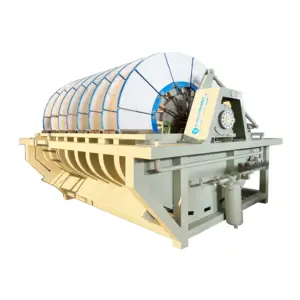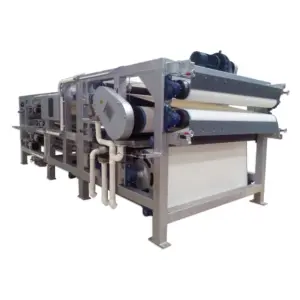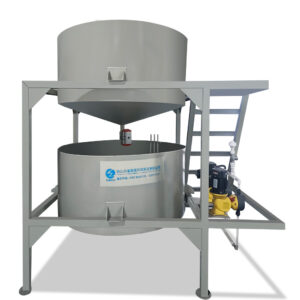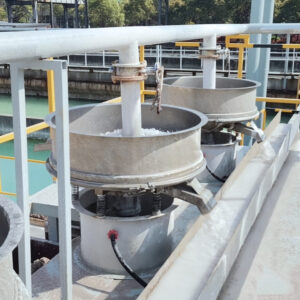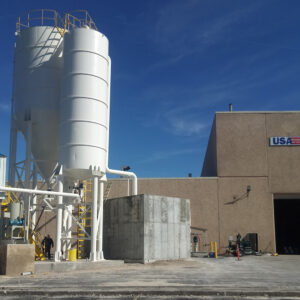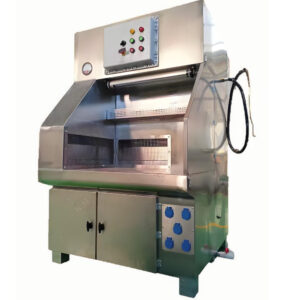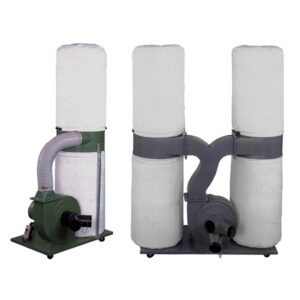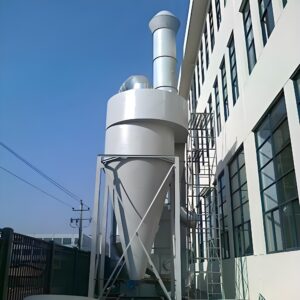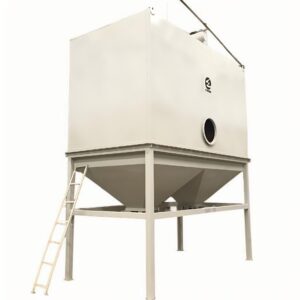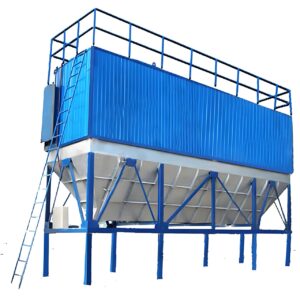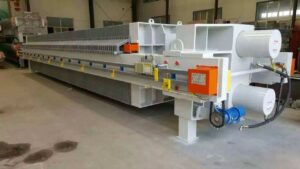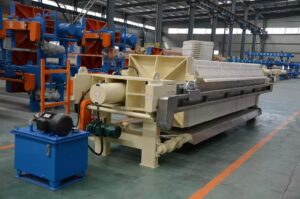Wastewater treatment is a critical process in maintaining environmental health and ensuring the sustainability of our water resources. Among the various methods employed in this field, belt presses have emerged as an effective and efficient solution for solid-liquid separation. This article delves into the intricacies of belt press technology and its role in modern wastewater treatment methods.
Belt presses are mechanical dewatering devices that use the principles of gravity drainage, chemical conditioning, and mechanical pressure to remove water from sludge and slurries. These machines have gained popularity in recent years due to their ability to handle large volumes of wastewater while maintaining high efficiency and low operational costs.
As we explore the world of belt presses in wastewater treatment, we'll examine their design, operation, advantages, and applications. We'll also compare belt presses to other dewatering technologies and discuss their environmental impact. By the end of this article, you'll have a comprehensive understanding of how belt presses contribute to effective wastewater treatment and why they're becoming increasingly prevalent in treatment facilities worldwide.
Belt presses are a crucial component in modern wastewater treatment systems, offering a balance of efficiency, cost-effectiveness, and environmental sustainability.
How do belt presses work in wastewater treatment?
Belt presses are ingenious machines that utilize a series of steps to separate solids from liquids in wastewater. The process begins with the introduction of chemically conditioned sludge onto a gravity drainage zone. Here, free water is removed through gravity and the sludge begins to thicken.
As the sludge moves through the machine, it enters a low-pressure zone where it's sandwiched between two porous belts. These belts apply gentle pressure, squeezing out more water. Finally, the sludge passes through a high-pressure zone where maximum dewatering occurs.
The key to the belt press's effectiveness lies in its ability to progressively increase pressure on the sludge, allowing for optimal water removal without damaging the equipment or compromising the quality of the separated solids. This gradual approach also helps in maintaining a consistent cake solids concentration, which is crucial for further processing or disposal.
Belt presses can achieve solid concentrations of up to 30% in the final cake, significantly reducing the volume of waste that needs to be handled and disposed of.
| Parameter | Value |
|---|---|
| Typical feed solids | 1-4% |
| Final cake solids | 15-30% |
| Polymer consumption | 2-10 kg/ton dry solids |
| Typical capacity | 5-30 m³/h |
The operation of belt presses in wastewater treatment methods is a testament to the ingenuity of modern engineering, combining mechanical principles with chemical processes to achieve optimal results in solid-liquid separation.
What are the advantages of using belt presses in wastewater treatment?
Belt presses offer numerous advantages in wastewater treatment, making them a preferred choice for many treatment facilities. One of the primary benefits is their high throughput capacity, allowing for the processing of large volumes of wastewater in a relatively short time.
Another significant advantage is the belt press's energy efficiency. Compared to other dewatering technologies, belt presses consume less power, translating to lower operational costs and a reduced carbon footprint. This aligns well with the growing emphasis on sustainable wastewater treatment practices.
Belt presses also excel in producing a drier final product. The multi-stage dewatering process results in a cake with higher solid content, which is beneficial for disposal or further processing. This not only reduces transportation costs but also minimizes the environmental impact of waste disposal.
Belt presses can reduce the volume of sludge by up to 90%, significantly decreasing disposal costs and environmental impact.
| Advantage | Impact |
|---|---|
| Energy Efficiency | 30-50% less energy consumption compared to centrifuges |
| Volume Reduction | Up to 90% reduction in sludge volume |
| Operational Cost | 20-40% lower than alternative dewatering methods |
| Maintenance | Simple design leads to lower maintenance requirements |
PORVOO, a leading manufacturer in the field, has been at the forefront of developing advanced belt press technologies that maximize these advantages, further cementing the role of belt presses in effective wastewater treatment.
How do belt presses compare to other dewatering technologies?
When evaluating wastewater treatment methods, it's essential to compare belt presses with other dewatering technologies such as centrifuges, screw presses, and filter presses. Each technology has its strengths and weaknesses, and the choice often depends on specific operational requirements and waste characteristics.
Belt presses stand out for their continuous operation capability, which allows for high throughput and consistent performance. They also offer excellent flexibility in handling various types of sludge, from municipal wastewater to industrial slurries.
In terms of energy consumption, belt presses generally outperform centrifuges, which require high-speed rotation and consequently more power. However, centrifuges may achieve slightly higher solid concentrations in some applications.
Compared to screw presses, belt presses typically have a higher capacity and can handle a wider range of sludge types. Filter presses, while capable of producing very dry cakes, operate in batches and may have longer cycle times than continuous belt presses.
Belt presses offer a balance of performance, flexibility, and cost-effectiveness that makes them suitable for a wide range of wastewater treatment applications.
| Technology | Cake Dryness | Energy Use | Footprint | Continuous Operation |
|---|---|---|---|---|
| Belt Press | 15-30% | Low | Medium | Yes |
| Centrifuge | 20-35% | High | Small | Yes |
| Screw Press | 15-25% | Medium | Small | Yes |
| Filter Press | 30-45% | Medium | Large | No |
The choice between these technologies often comes down to specific operational needs, but the versatility and efficiency of belt presses make them a compelling option for many wastewater treatment facilities.
What role do polymers play in belt press operation?
Polymers play a crucial role in enhancing the performance of belt presses in wastewater treatment. These chemical additives, also known as flocculants, are introduced to the sludge before it enters the belt press. Their primary function is to improve the separation of solids from liquids by promoting the aggregation of small particles into larger, more easily filterable flocs.
The selection of the right polymer is critical to the efficiency of the belt press operation. Factors such as sludge type, pH, and desired cake dryness all influence the choice of polymer. Cationic polymers are commonly used due to their effectiveness in neutralizing the negative charges on sludge particles, facilitating better flocculation.
Proper polymer dosing is equally important. Insufficient polymer can lead to poor flocculation and reduced dewatering efficiency, while overdosing can result in unnecessary costs and potential environmental concerns. Many modern belt press systems include automated polymer dosing systems to optimize this process.
Effective polymer conditioning can increase the solids capture rate of belt presses to over 95%, significantly improving the overall efficiency of the dewatering process.
| Parameter | Without Polymer | With Optimal Polymer |
|---|---|---|
| Solids Capture Rate | 60-70% | 95-99% |
| Cake Dryness | 10-15% | 15-30% |
| Filtrate Clarity | Poor | Excellent |
| Belt Life | Shorter | Longer |
The use of polymers in belt press operations exemplifies the synergy between chemical and mechanical processes in modern wastewater treatment methods, contributing to more effective and efficient solid-liquid separation.
How do belt presses contribute to environmental sustainability?
Belt presses play a significant role in enhancing the environmental sustainability of wastewater treatment processes. By efficiently dewatering sludge, they reduce the volume of waste that needs to be transported and disposed of, leading to a decrease in transportation-related emissions and landfill usage.
The reduced volume of sludge also opens up more possibilities for beneficial reuse. Dewatered sludge can be more easily composted, used as a soil amendment, or even incinerated for energy recovery. These alternatives to landfill disposal contribute to a more circular economy approach to waste management.
Furthermore, the energy efficiency of belt presses compared to some other dewatering technologies translates to a lower carbon footprint for treatment facilities. This aligns with global efforts to reduce energy consumption and mitigate climate change impacts.
By reducing sludge volume by up to 90%, belt presses significantly decrease the environmental impact of wastewater treatment, from reduced transportation emissions to decreased landfill usage.
| Environmental Aspect | Impact of Belt Presses |
|---|---|
| Landfill Usage | Reduced by up to 90% |
| Transportation Emissions | Decreased by 70-80% |
| Energy Consumption | 30-50% lower than centrifuges |
| Water Recovery | Up to 99% of water removed can be recycled |
The contribution of belt presses to environmental sustainability underscores their importance in modern wastewater treatment methods, aligning with global goals for responsible resource management and environmental protection.
What maintenance is required for optimal belt press performance?
Proper maintenance is crucial for ensuring the longevity and optimal performance of belt presses in wastewater treatment facilities. Regular maintenance not only prevents unexpected breakdowns but also helps maintain the efficiency of the dewatering process.
One of the most critical maintenance tasks is the regular cleaning of the filter belts. Over time, sludge and other materials can accumulate on the belts, reducing their permeability and consequently the press's efficiency. High-pressure washing systems are typically used for this purpose, often integrated into the belt press design for automatic cleaning cycles.
Belt tension and alignment are also key factors in maintaining optimal performance. Improper tension can lead to belt slippage or premature wear, while misalignment can cause uneven dewatering and potentially damage the belts. Regular checks and adjustments are necessary to ensure proper operation.
Implementing a comprehensive maintenance program can extend the life of belt press components by up to 50% and maintain peak operational efficiency.
| Maintenance Task | Frequency | Impact on Performance |
|---|---|---|
| Belt Cleaning | Daily | Maintains dewatering efficiency |
| Belt Tension Check | Weekly | Prevents slippage and uneven wear |
| Roller Inspection | Monthly | Ensures smooth operation |
| Lubrication | As per manufacturer's recommendation | Reduces wear and energy consumption |
| Full System Inspection | Annually | Identifies potential issues early |
Regular maintenance not only ensures the longevity of the equipment but also contributes to consistent performance, which is crucial for maintaining the overall efficiency of wastewater treatment processes.
What future developments can we expect in belt press technology?
The field of wastewater treatment is continuously evolving, and belt press technology is no exception. As we look to the future, several exciting developments are on the horizon that promise to enhance the efficiency, sustainability, and versatility of belt presses.
One area of focus is the development of advanced materials for filter belts. Researchers are exploring new synthetic fibers and coatings that could improve filtration efficiency, increase belt longevity, and reduce the need for polymer conditioning. These innovations could lead to significant improvements in both the performance and cost-effectiveness of belt presses.
Automation and smart technology integration are also set to play a larger role in belt press operations. Advanced sensors and control systems can optimize process parameters in real-time, adjusting to variations in sludge characteristics for maximum efficiency. This could lead to improved dewatering performance and reduced operator intervention.
Future belt presses may incorporate AI-driven control systems, potentially increasing dewatering efficiency by up to 20% while reducing energy consumption and polymer usage.
| Future Development | Potential Impact |
|---|---|
| Advanced Belt Materials | 30% increase in filtration efficiency |
| Smart Control Systems | 20% improvement in overall performance |
| Energy Recovery Systems | Up to 15% reduction in energy consumption |
| Modular Design | 50% reduction in installation and upgrade time |
As these technologies mature, we can expect belt presses to become even more integral to efficient and sustainable wastewater treatment methods, further cementing their position as a key technology in water resource management.
Conclusion
Belt presses have proven to be a versatile and efficient solution for solid-liquid separation in wastewater treatment. Their ability to handle large volumes of sludge, coupled with their energy efficiency and relatively low operational costs, makes them an attractive option for many treatment facilities.
Throughout this article, we've explored the working principles of belt presses, their advantages over other dewatering technologies, and their contribution to environmental sustainability. We've also discussed the importance of proper maintenance and the role of polymers in optimizing their performance.
Looking to the future, belt press technology continues to evolve, with promising developments in materials science, automation, and smart control systems on the horizon. These advancements are set to further enhance the efficiency and effectiveness of belt presses in wastewater treatment.
As we continue to face global challenges related to water scarcity and environmental protection, the role of effective wastewater treatment becomes increasingly crucial. Belt presses, with their balance of performance, cost-effectiveness, and sustainability, are well-positioned to play a significant part in addressing these challenges.
In conclusion, belt presses represent a key technology in modern wastewater treatment methods, offering a robust solution for solid-liquid separation that aligns with the goals of efficient resource management and environmental stewardship. As we move forward, their continued development and implementation will undoubtedly contribute to more sustainable and effective wastewater treatment practices worldwide.
External Resources
Wastewater treatment – Wikipedia – This article provides a comprehensive overview of wastewater treatment methods, including biological, chemical, and physical processes. It details oxidation, anaerobic treatment, and the conversion of wastewater into reusable effluent.
Arvia Technology – This resource compares various tertiary water treatment technologies, including Nyex™, activated carbon, Fenton process, and UV AOP. It highlights the benefits and limitations of each method.
Dombor – This article outlines conventional and advanced wastewater treatment methods, including mechanical, biological, and chemical processes. It also covers specific technologies like ceramic membrane filtration, aerobic and anaerobic processes, and ultraviolet irradiation.
Care Water Solutions – This resource compares various water treatment technologies such as ion exchange, activated carbon, ozone treatment, filtration, UV treatment, and reverse osmosis. It discusses the benefits and applications of each technology.
Wikipedia's Wastewater Treatment – This section within the Wikipedia article covers chemical oxidation, which includes advanced oxidation processes like those using ozone, chlorine, or hypochlorite.
Care Water Solutions – Activated Carbon – This section within the comparison article focuses on the use of activated carbon in water treatment, highlighting its effectiveness in removing pollutants and improving water taste and odor.
Care Water Solutions – Reverse Osmosis – This part of the comparison article explains the reverse osmosis technology, its ability to remove contaminants without chemicals, and its application in treating seawater and brackish water.
Care Water Solutions – UV Treatment – This section discusses UV water treatment, its rapid treatment process, and its ability to convert organic matter into stable compounds without producing secondary waste like sludge.
